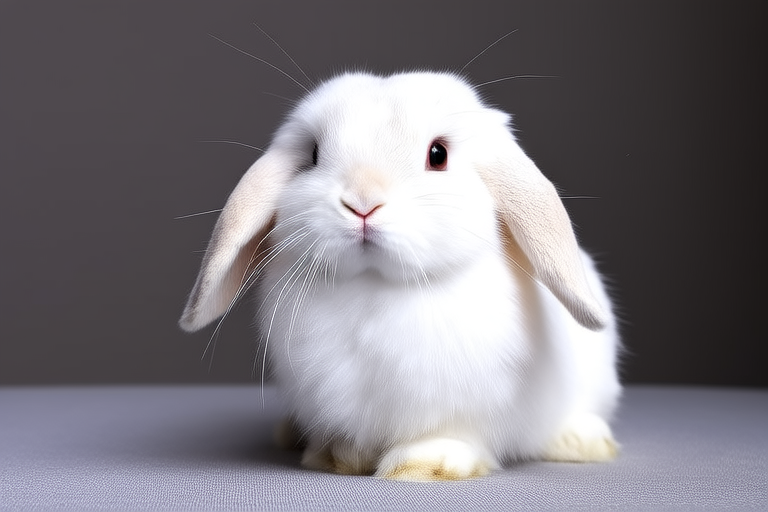Hotot Rabbit Care Guide: Tips for Raising This Adorable and Special Breed
The Hotot rabbit is a breed known for its striking white fur and black or blue eyes, giving it an almost mystical appearance. These rabbits have been a favorite among rabbit enthusiasts for their unique looks and friendly demeanor. Whether you’re a seasoned breeder or a first-time owner, this guide will provide you with all the information you need to care for your Hotot rabbit properly.
Introduction to Hotot Rabbits
Originating from France, the Hotot rabbit was developed by Eugène Émile Ovin during the early 20th century. The breed’s name comes from the town of Hotot-en-Auge, where it was first bred. The Hotot rabbit is recognized for its distinctive white coat and dark ring around each eye, which gives it a charming and endearing look. Their temperament is generally calm and friendly, making them ideal pets for families and individuals alike.
Housing Requirements
Providing the right living environment is crucial for your Hotot rabbit’s well-being. A spacious hutch that allows plenty of room for movement is essential. The hutch should be at least 3 feet wide, 2 feet deep, and 2 feet high per rabbit. Make sure the hutch has good ventilation and is placed in a location that provides protection from extreme weather conditions. Inside the hutch, include a comfortable bedding area, such as straw or hay, and a feeding area. Additionally, consider providing ramps or platforms to allow your rabbit to explore different levels within its enclosure.
Diet Specifics
A balanced diet is key to maintaining your Hotot rabbit’s health. Their primary food source should be high-quality hay, which helps maintain dental health and aids digestion. Pellets designed specifically for rabbits should make up about 1/4 cup per 5 pounds of body weight daily. Fresh vegetables like carrots, bell peppers, and leafy greens can be offered in moderation. Always introduce new foods gradually to avoid digestive upset. Clean, fresh water should always be available, either through a sipper bottle or a heavy ceramic dish.
Grooming Needs
Despite their short fur, Hotot rabbits still require regular grooming to keep their coats healthy and free from mats. Brush your rabbit weekly with a soft-bristled brush to remove loose hairs and prevent matting. During shedding season, more frequent brushing may be necessary. Bathing should only be done when absolutely necessary, as rabbits prefer to groom themselves. If bathing is required, use a gentle, rabbit-safe shampoo and ensure the rabbit is thoroughly dried afterward to prevent chills.
Exercise Recommendations
Rabbits need regular exercise to stay fit and happy. In addition to their indoor hutch, provide a safe outdoor space where they can run and play. A securely fenced yard or a large, enclosed area is ideal. Supervised playtime indoors is also beneficial, allowing your rabbit to explore and burn off energy. Ensure any indoor area is bunny-proofed, removing potential hazards like electrical cords and toxic plants. Providing toys and tunnels can stimulate mental and physical activity.
Health Concerns
Like all breeds, Hotot rabbits are susceptible to certain health issues. Common problems include dental disease, respiratory infections, and digestive disorders. Regular veterinary check-ups are essential to catch and address any health issues early. Signs of illness may include changes in appetite, lethargy, discharge from the nose or eyes, or difficulty breathing. Proper nutrition, clean living conditions, and routine care can help prevent many of these issues.
Breeding Considerations
If you’re considering breeding your Hotot rabbits, it’s important to understand the responsibilities involved. Breeding should only be done by experienced breeders who are committed to improving the breed’s quality. Prospective breeders should research and adhere to ethical breeding practices, ensuring genetic diversity and avoiding inbreeding. Health testing and careful selection of breeding pairs are crucial to produce healthy offspring. Newborn kits require special care, including warmth, hydration, and monitoring for signs of distress.
Bonding and Training
Building a strong bond with your Hotot rabbit takes time and patience. Spend quality time with your rabbit daily, offering treats and gentle handling. Positive reinforcement techniques can be used to train your rabbit to come when called or perform simple tricks. Clicker training is particularly effective for rabbits. Consistency and repetition are key to successful training. Socialization is also important; exposing your rabbit to various people and environments can help build confidence and reduce fearfulness.
In conclusion, raising a Hotot rabbit can be a rewarding experience for both you and your pet. By providing proper care, attention, and love, you can ensure your Hotot rabbit lives a long, healthy, and happy life. Remember, each rabbit is unique, so pay close attention to your pet’s individual needs and preferences. With dedication and effort, you’ll enjoy a wonderful companionship with your Hotot rabbit.
